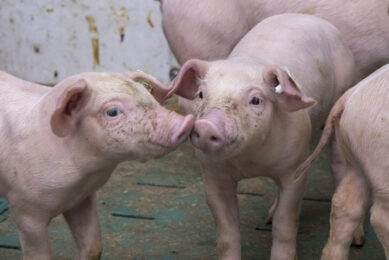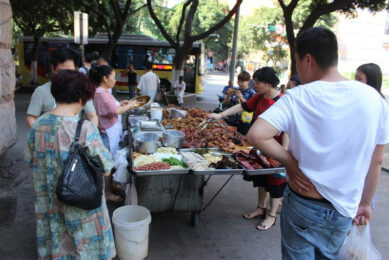The world visits China – and China goes abroad
Although not as well visited as hoped, VIV China, Beijing, 6-8 Sept 2010, was still a vibrant place, where a lot of international demand and supply met. An interesting two-way curiosity could be noted. Where western companies try to find opportunities to build and expand strongholds in China, Chinese agricultural companies have definitely started sniffing abroad.
New takes over old at a dazzling pace, in a country that is catching up with modern and western lifestyle. Population growth in China is combined with a rapidly growing average income, which leads to strongly increased
demand for proteins. Add to this the development of multimillion-head cities that continue to attract thousands of people from the countryside; and a government that encourages the development of modern agricultural practices in an attempt to improve food safety. In a nutshell, this explains why China, especially for the international pig industry, is the place to be.
At the moment, it is estimated that 60% of total poultry in China comes from backyard production. With pigs, this percentage is thought to be about 80%. As is more often the case, the more dynamic poultry industry took the lead in developing mass investment projects, but many international companies indicated that the investments in the pig industry have now really caught on as well. And since pork is the most important meat in China, the end is not yet near for a good while.
Despite all these good omens and a domestic growth rate of 9-11%, the global crisis could not prevent a slight return in visitor numbers, show organisers VNU Exhibitions reported. Approximately 350 exhibitors from 24 countries attended the show, which was approximately a 100 less than the 2008 edition. More than 240 companies came from China, the rest, just over 100, complementing the total figure from abroad. Just under 10,000 visitors from at least 67 countries made it to the show.Ruwan Berculo, project manager Asia-Pacific for VNU Exhibitions, declared there were various reasons why exhibitor and visitor numbers did not meet those of 2008’s show. He said a lot of companies had decided to invest in VIV Europe, earlier this year in the Nether-lands; in addition, there was some competition with SPACE, held in France a week after the show in China, causing many French companies to stay away. Last but not least, the financial crisis did have its impact, said Berculo.
Long and winding
For foreign companies, investing in China can be a long and winding road – and perhaps nothing is as deceptive as jubilant trade perspectives suggesting that any action will be rewarded tenfold with the press of one button. Making profit in China is very well possible, but requires a careful approach, hence many of the companies present in Beijing told similar stories. These are tales of initally frequent travel, establishing a permanent representation through agents or offices, and eventually even one or more production locations. These are also tales of slowly gaining confidence, the fear of being copied and initiatives to educate and transfer know-how.
Jansen Poultry Equipment, headquartered in Barneveld, the Netherlands, was present in Beijing to promote its innovative poultry housing and feeding systems. For the company, it was the second time it was present at a big show like this in China. Recently, the company has adopted a different mentality towards trading with China, Mari van Gruijthuijsen, general manager explained. “For a long time, we were thinking – if we come to China, our products will be copied a lot of the time. We now got over this as we understand that customers are looking for solutions and systems rather than products.”Key to this change, Van Gruijthuijsen said, was the conviction that being copied would involve far more than just producing steel or plastic. For that, he drew a much-heard comparison between a sophisticated product portfolio and a computer. “I think what is unique for our products is our philosophy, our hardware. Our hardware may perhaps be copied, but the software cannot.” In other words, eventually, he believes quality and a systematic approach will prevail.
About one and a half years ago, the company found itself a Chinese partner. First, the company helped this customer set up its own equipment division. From there, Jansen Poultry Equipment hopes to be able to expand and to reap the harvest. “I am very positive,” Van Gruijthuijsen indicated. “First, however, we will have to work very hard for a couple of years. I expect everything will catch on eventually. If necessary, at a later stage, we can see if we would need an extra production location in China.”
Steep learning curve
Poultry and pig equipment manufacturer Big Dutchman, headquartered in Vechta, Germany, already celebrated 15 years of physical presence in China. The company just finished the relocation of its Chinese sales team to Beijing. The company hopes to attract more internationally focused employees when being situated in the country’s capital. Meanwhile, the company’s development and logistics team remains located in Tianjin, at 150 km South East of Beijing.
China definitely is a booming market, said Magnus Westerkamp, managing director of Big Dutchman Pig Equipment. The company’s turnover growth in China has been well above the Big Dutchman global average, which was 30% last year. Success did not come just like that, Westerkamp said, speaking of a ‘steep learning curve’, when it came down to developing itself on the Chinese market. “One of the reasons for our success is hidden in the fact that we managed to adapt products to the Chinese market. For instance, we built a farrowing crate in the Chinese style – i.e. with a front gate – as we simply cannot sell just the European crates.”Finding the right staff, now about 120 in China alone, could also sometimes be a challenge. Especially difficult to find is educated staff who can do on-farm fitting and also can speak English. “Sometimes we would like to be commenting on something, but my knowledge of Chinese may be too little to express myself,” indicated Kim Nielsen, national sales manager – pig equipment.
Chinese companies
Just like many companies being interested in investing in China, there are plenty of Chinese companies looking for opportunities to expand abroad. Knowing that labour is relatively affordable in China, once equipped with the right amount of knowledge, these companies can do serious business when exporting.
For Chinese companies, however, the outside world may be as much a challenge as it is for western companies to expand into China. Patent regulations, language differences, large conglomerates and cultural differences may pose difficulties for them.
Based in Qingdao, Shandong province, livestock manufacturer Big Herdsman started its business in 2002, after having been a business partner of Big Dutchman for some years. The company initially focused on poultry equipment, manufacturing and selling e.g. feed lines and ventilation systems. About five years ago, the company went international with sales now extending to the rest of Asia and also the Middle East. According to Ami Shi, working at the company’s international department, sales in total have grown by 100% each year so far. “We focus on innovative quality – we try to sell the best available in China,” Shi said. Two years ago, the company also started producing for the swine market as well, like e.g. there are sow crates and feeding equipment, but these products have not yet gone abroad. “We will have to wait another two to three years until our product lines have matured,” she said. We have a good reputation and we would lose reputation if we cannot live up to the expectations.”
ZCME
Being some steps further in its international development, is the Shanghai ZhengChang International Machinery and Engeneering company (ZCME). The feeding equipment company, which exists since 1918, is said to have about 60% market share in constructing pellet mills in China for poultry and pig feed. The company started to look abroad as early as 1996 – and has developed a strong exporting business ever since, with operations running in South East Asia, the Middle East, North Africa and South America. Sales figures grew very rapidly and even now sales still double every two to three years.
At the moment, about 25% of ZCME’s projects is being conducted outside China, and it is likely that abroad is where the company’s growth is to be expected, said Hao Yun, board chairman. “What we see in China is that feed prices have been very low and this means that the smaller feed companies have the most limitations to survive in a competitive market. Their profit margins have been very low. What happens is that bigger companies, like New Hope or the Chia Tai Group buy this capacity, they buy these facilities instead of investing in new plants.”
“For this reason, we have chosen that we want to grow abroad with these big groups. CP Group, for instance, has started building a poultry feed plant in Bangladesh and they will use Chinese products and equipment for this, outside China.” PP
Source: Pig Progress magazine Volume 26. 8











